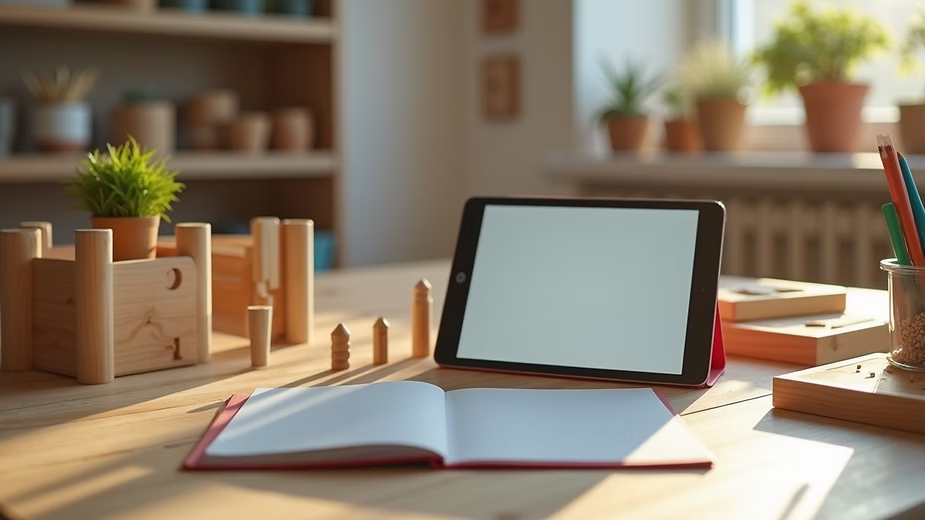Integrating Technology in Montessori Education: Balancing Benefits with Limited Screen Time for Young Children
- Luca Brussouw
- Oct 12
- 3 min read
In our technology-driven world, it’s vital to think about how we can use these tools to enhance our children's education. As a dedicated mom who embraces Montessori education, I regularly explore how to weave technology into my child’s learning experiences. While some see technology as a hindrance, I argue that it can be a valuable asset when used wisely and sparingly. In this post, I’ll guide you on how to integrate technology effectively into Montessori education, highlighting the necessity of limiting screen time for children under five.
Understanding Montessori Principles
At the heart of Montessori education lies the idea that children learn best through hands-on experiences and self-guided exploration. This method encourages independence, curiosity, and a passion for learning. In considering technology, I’ve found that it can enhance these principles rather than go against them.
For example, educational apps like "Endless Alphabet" introduce vocabulary in a fun and interactive way. Such tools not only make learning enjoyable but also support the foundational skills children need in early education. Essentially, technology can amplify the Montessori experience, allowing children to explore concepts in fresh, innovative ways.
The Role of Technology in Learning
Technology can act as a powerful resource within a Montessori environment. It opens doors to a vast array of knowledge and materials that may not be readily available in traditional classrooms. For instance, platforms like "Google Arts & Culture" allow children to embark on virtual journeys through famous museums and historical sites, igniting their imagination.
Additionally, many educational apps facilitate personalised learning. Programs like "ABCmouse" adapt to a child's learning pace, allowing them to focus on areas needing improvement while exploring subjects that pique their interest. This ability to tailor learning experiences aligns seamlessly with Montessori's principle of respecting each child’s unique learning style.
Choosing the Right Tools
Selecting the right technology to integrate into Montessori education is crucial. Not all tools are equally effective. As a parent, I recommend looking for educational apps that promote critical thinking, creativity, and problem-solving skills.
For example, apps like "Tynker" introduce basic coding concepts through engaging puzzles and games that enhance logical skills. Similarly, storytelling apps such as "Toontastic" allow children to create their own digital stories, fostering both creativity and language development. The goal is to identify tools that promote learning rather than simply entertain.
Setting Boundaries: Limited Screen Time

While technology can be advantageous, it’s essential to establish boundaries, particularly for young children. The American Academy of Pediatrics suggests limiting screen time to about one hour a day for children aged two to five, underscoring the value of active play and real-world interactions.
To maintain a healthy balance, I set specific times for technology use. For example, we dedicate 20 minutes each day to educational apps, following this with ample time for outdoor activities, reading, and hands-on projects. This creates an environment where technology supplements learning instead of replacing valuable real-life experiences.
Encouraging Active Engagement
To fully benefit from technology, active engagement is key, rather than passive consumption. I often join my child during screen time, asking questions and discussing our discoveries. This interaction deepens comprehension and strengthens our bond.
Moreover, I encourage my child to create content instead of merely consuming it. For instance, by using drawing apps, my child can express creativity while mastering colors and shapes. When children actively engage with technology, they cultivate critical thinking skills and a strong sense of involvement in their learning journey.
Blending Technology with Hands-On Learning
A highly effective strategy for merging technology into Montessori education is by combining it with hands-on experiences. After exploring a virtual zoo field trip, for instance, we might create animal crafts inspired by what we observed. This connection reinforces their learning and helps children associate digital experiences with tangible activities.
Additionally, I enhance traditional Montessori activities with technology. After working with a globe, we might research information about a country using a tablet. This blend of digital and physical exploration enriches the educational experience, adhering to Montessori ideals.
Embracing a Balanced Approach

Integrating technology into Montessori education can be incredibly fruitful if approached thoughtfully. By carefully selecting appropriate tools, setting screen time boundaries, and encouraging active engagement, we can cultivate a balanced learning environment that supports curiosity and creativity.
I believe technology isn’t bad, in fact, it can be a powerful ally when understood. When we use technology intentionally, we unlock its potential to enrich our children's learning experiences. Let's welcome the opportunities technology presents while staying true to the core values of Montessori education. Together, we can harmoniously blend hands-on learning with digital exploration, preparing our children for a bright future.










Comments